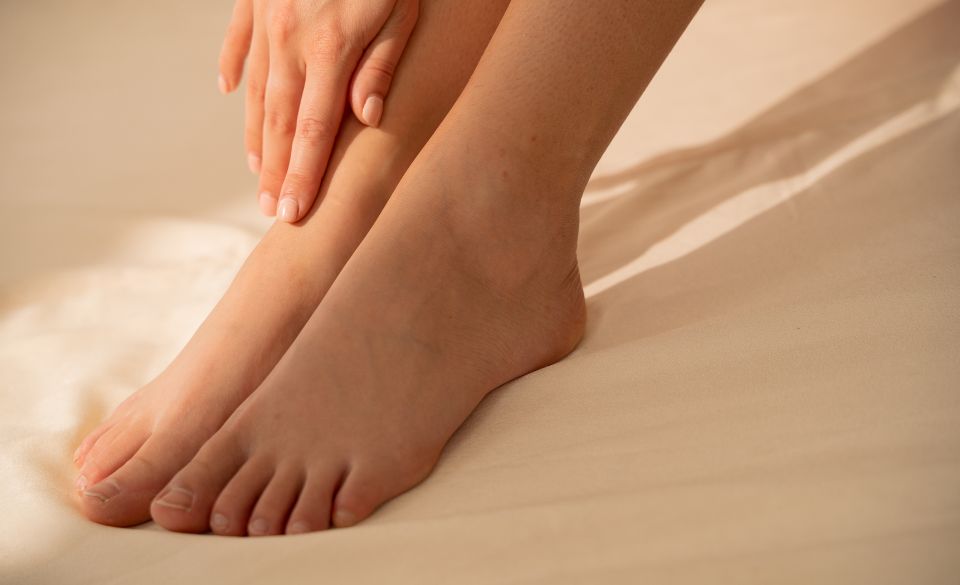
The Best Home Remedies For Sore Feet: A Complete Guide
Page Contents
- Why Do My Feet Hurt After Exercise?
- Potential Causes of Post-Exercise Foot Pain
- 8 Best Home Remedies For Sore Feet
- 1. Apply Ice
- 2. Try Nonsteroidal Anti-Inflammatory Drugs (NSAIDs)
- 3. Wear Different Shoes
- 4. Use the RICE Method
- 5. Put the Feet Up
- 6. Stretch the Feet
- 7. Stretch the Calves
- 8. Bathe the Feet
- Preventing Foot Discomfort During Exercise – Tips
- Final Words – The Best Home Remedies For Sore Feet
Home remedies can offer effective relief for foot pain and swelling, addressing discomfort caused by various factors, from trauma to arthritis, bursitis, and sore feet after training. Here are 8 of the best home remedies for sore feet, read on to learn more:
Why Do My Feet Hurt After Exercise?
Foot pain is a common occurrence, particularly during and after exercise. In the realm of physical activity, our feet serve as vital indicators, signaling underlying issues that may affect our entire body. When foot pain follows exercise, its severity can provide valuable insights into potential causes. Here are explanations for why feet may hurt after physical activity:
Potential Causes of Post-Exercise Foot Pain
Plantar Fasciitis: The Plantar Fascia, a tendon running from the heel to the toes along the sole of the foot, can become inflamed when subjected to excessive strain. This condition often arises due to inadequate footwear or engaging in high-intensity workouts without proper warm-up. The resultant discomfort is noticeable when walking or bearing weight on the feet. If left untreated, Plantar Fasciitis can lead to more severe damage. Effective treatment options vary depending on the underlying cause but typically involve rest, stretching, and targeted exercises, which a physiotherapist can recommend based on your specific needs. Using insoles like the Redux Heel 2 can also offer valuable support to the foot, potentially expediting the healing process.
Stress Fractures: The human foot comprises 26 bones, each contributing to its mobility regardless of the direction of movement. When one or more of these bones endure repetitive stress, they may develop stress fractures. These fractures can be easily exacerbated by stepping on uneven surfaces like tree roots or rocks, stumbling into potholes, or experiencing abrupt movements. Initially, the pain may not be severe, but it tends to intensify over time if left untreated. Suspecting a stress fracture warrants prompt medical attention, including X-rays for confirmation, and necessitates rest to allow for recovery.
Extensor Tendonitis: If you begin to experience tightness and pain in the upper part of your foot, particularly when attempting to straighten your toes or flex your foot, it is likely that the tendons running along the top of your foot have become inflamed. This condition can lead to significant discomfort, particularly when raising your toes. Extensor Tendonitis is often triggered by factors such as inappropriate footwear, a tight Achilles tendon, or complications in the calf muscles. Consulting a physiotherapist or chiropractor is advisable for identifying the root cause and devising a treatment plan that may encompass stretches, strength-building exercises, and selecting suitable footwear.
8 Best Home Remedies For Sore Feet
Foot discomfort can be a common and debilitating issue that affects people for various reasons, from strenuous physical activity to underlying medical conditions. While the causes of sore feet may vary, there is a wealth of home remedies that can offer effective relief and help you regain your mobility and comfort. Below we present a comprehensive guide to the eight best home remedies for sore feet, offering practical and accessible solutions to address the pain and swelling associated with foot issues. Whether you’re dealing with the aftermath of an intense workout or chronic conditions like plantar fasciitis, our remedies will empower you to take control of your foot health and well-being from the comfort of your own home.
1. Apply Ice
Using a cold pack or homemade ice pack can provide relief for foot pain associated with joint issues, trauma, infection, inflammation, arthritis, bursitis, or gout. Ensure not to place ice directly on the skin. Wrap ice or frozen vegetables in a cloth or towel and apply it to the painful foot for 15–20 minute intervals. Alternatively, roll the affected area over a cold or frozen water bottle, which is especially beneficial for those with plantar fasciitis.
2. Try Nonsteroidal Anti-Inflammatory Drugs (NSAIDs)
Aspirin and ibuprofen, both NSAIDs, help alleviate pain and reduce inflammation, making them suitable for foot pain associated with conditions like arthritis, bursitis, gout, or swollen and tired feet. These medications are available over the counter but should be taken with food or milk, and alcohol consumption should be avoided while using them.
3. Wear Different Shoes
Ill-fitting or uncomfortable footwear can be a source of foot pain. Switching to low-heeled, comfortable shoes is particularly helpful for relieving arch pain and swollen feet, especially during pregnancy. Individuals with plantar fasciitis can benefit from wide shoes with cushioned soles and may find cushioned insoles useful. Comfortable shoes also aid in preventing painful ingrown toenails, with professional advice recommended for their management.
4. Use the RICE Method
The RICE method, which stands for Rest, Ice, Compression, and Elevation, is advised for individuals with foot sprains or fractures. Rest is crucial to avoid worsening soft tissue injuries, and ice application in the first 48 hours should be followed for 15–20 minute intervals throughout the day. Compression via a snug bandage is important, with care taken not to impede circulation. Elevation involves lying down and raising the injured foot above heart level to reduce swelling.
5. Put the Feet Up
Elevating the feet on a footstool or chair can provide relief for sore, tired, or swollen feet, which is particularly relevant during pregnancy when excess fluid accumulation may lead to swelling.
6. Stretch the Feet
Regular foot stretching can help prevent painful arches and plantar fasciitis-related discomfort. Toe curl exercises and marble pickups are effective stretches for foot health.
Toe Curl: Place a towel on the floor, sit in a chair with the foot on top of the towel, use the towel to pull the toes toward the body.
Marble Pickups: Put marbles and a cup on the floor, pick up marbles with the toes while keeping the heel on the floor, and place them in the cup.
7. Stretch the Calves
Tight calf muscles can contribute to foot pain. Stretching the calves is beneficial and can be done by leaning against a wall, stepping forward with one leg, bending the front knee to stretch the calf muscle of the other leg, and holding the position for 10–30 seconds before repeating with the other leg.
8. Bathe the Feet
Soaking sore, painful, or tired feet in warm water can be soothing. Some individuals find that adding Epsom salts to the water enhances the relief.
These home remedies offer accessible and effective solutions to alleviate foot pain and swelling, providing individuals with practical tools to manage their discomfort.
Preventing Foot Discomfort During Exercise – Tips
Choosing the Appropriate Equipment: Selecting the right workout gear can significantly impact your exercise experience, particularly if you’re dealing with foot pain or injury. A helpful checklist for what to consider includes:
– Opting for well-fitted shoes that establish optimal contact and support for your feet.
– Wearing socks that offer a snug yet comfortable fit, featuring compression and cushioning.
– Incorporating insoles that alleviate heel pressure and provide arch support.
– Utilizing a quality workout mat, especially when exercising on unforgiving surfaces such as concrete or similar hard substrates.
Stretching and Strengthening: Engaging in exercises that target your calves, Achilles tendons, plantar fascia, and shins can promote tendon flexibility and reduce strain. Effective exercises to consider involve heel stretches, rolling a tennis or golf ball underfoot, calf raises, towel curls, stair arch raises, and arch lifts.
Establishing a Routine: Physical activities like running on rigid surfaces such as concrete or asphalt can subject your feet to substantial stress, potentially exacerbating any preexisting issues. Whenever possible, opt for softer terrains like grass, dirt, or astro-turf. Conversely, it’s advisable to avoid sandy surfaces due to their uneven nature, which could lead to ankle and knee problems.
Equally important is practicing moderation. Although the impulse to exert yourself strenuously from the outset can be tempting, your body may not respond favorably to such an approach. Initiate your fitness journey with gentle exercises and progressively intensify your routine over time for better results and minimal discomfort.
Final Words – The Best Home Remedies For Sore Feet
This comprehensive guide offers invaluable insights into addressing sore feet with the best home remedies, tackling discomfort stemming from various causes, including trauma, inflammation, and more. Our detailed list of eight top home remedies empowers you to manage and alleviate foot pain effectively. To understand why your feet may hurt after exercise, we explored potential causes, each requiring distinct considerations. With these remedies and insights at your disposal, you are well-equipped to combat foot discomfort and enhance your overall well-being.



